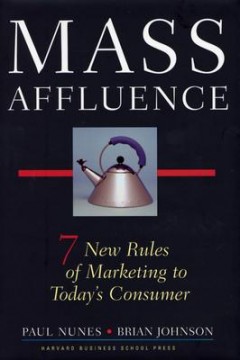
To get what I mean, see how this strikes you. It’s from the jacket copy of Paul Nunes and Brian Johnson’s book Mass Affluence: Seven New Rules of Marketing to Today’s Consumer (Harvard Business School Press):
Millions of consumers can now afford to pay more for everything—from household cleaning products to clothing to automobiles. Yet these “moneyed masses” are not spending nearly what their disposable incomes allow. This lack of spending translates into a huge, unspoken-for portion of affluent customers’ paychecks—a bounty waiting to be won by today’s marketers.
The book was published in 2004. In those halcyon days before our present woes, we weren’t spending enough? Yeah. Sure. Onetime Linens ‘n Things employee Debbie Jeffries said this after mentioning people at her cash register, their wallets ablossom with more credit cards than a Chase Manhattan spring: “That people can pull out that many credit cards—that’s insane. You say, whoa, maybe that’s why we’re here. We have so much debt.” Safer to say we were spending far too much.
What Jeffries saw anecdotally is borne out by the numbers. As a percentage of disposable income consumer and mortgage debt rose from 77% in 1990 to 127% in 2008, according to the Economist.
When Nunes and Johnson published, it was well over 100%. People are shoveling deeper and deeper holes and somehow these guys miss all the dirt flying through the air? It wasn’t just them. It has to do with how the wider culture pictures people engaged in buying and selling.
Words like consumer or customer have deeper meanings than our offhanded ways of tossing them about might indicate. Those deeper meanings affect how we think. In the blockquoted graf above these mythic people with gobs of money are not customers. They’re targets, opportunities. The term customer is used, but it’s an editorial choice. Mr. Roget was given breath precisely to prevent copywriters from having to repeat themselves.
The trouble is this. Use of the word consumer tends to debase, even dehumanize, the business relationship. It reduces people to the lowest level of identification in the transaction. Look at the etymology; the root means to take. Taking is certainly occurring. But it’s the most basic thing. There is nothing elevated about it. There is nothing that assumes value beyond what the person is doing in the transaction. There’s nothing transcendent or reflective of human dignity. People are what we can sell them.
Customer gets at something richer and fuller. It implies ongoing, interpersonal relationship, not merely a transaction. A customer is accustomed to your business. The word’s Latin parent means to make one’s own. Your business becomes the customer’s concern, and vice versa. There’s something personal and relational built into the concept.
The difference for business is this. You can use a consumer. You can think of them as a mere target for your wares and services, an opportunity for a sale. Not so with a customer. There is a relational responsibility inherent to treating people like customers, something more fulfilling, more affirming of the other’s humanity, and ultimately better for business. Such a picture of people strengthens social bonds (and the trust that trade depends upon) rather than looking for yet more inventive ways to extract their financial worth with no regard for social consequence.
Perhaps another way to think of it is this: Consumers are means to an end. Customers are ends in themselves.












